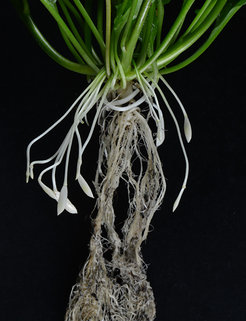Buried treasure: a plant that makes flowers and fruits underground
Researchers describe the unusual trait of amphicarpy, where two types of fruit develop on the same plant: one above- and the other below-ground.
Plants have evolved numerous strategies to spread their seeds widely. However, only a fraction of this trait diversity is accessible through the study of model organisms. In a recent study published in New Phytologist, Dr Angela Hay and colleagues – from the Max Planck Institute for Plant Breeding Research in Cologne, Germany – establish Cardamine chenopodiifolia as a new experimental system to help bridge this gap.

Cardamine chenopodiifolia is amphicarpic, meaning that each plant produces two types of fruit, with one type buried underground. The two types of fruit use very different mechanisms to disperse their seeds, allowing the plant to follow a bet-hedging strategy.
Aerial fruit employ explosive seed dispersal – typical of all Cardamine species. The fruit consist of two, long valves that enclose the seeds. When the seeds are ready for dispersal, these valves rapidly separate and coil back, firing many seeds out across a large area.
In stark contrast, the underground fruit are non-explosive and produce fewer, larger seeds that are buried below ground. The authors traced the origin of these underground fruit back to tiny floral buds at the growing tip of the main shoot. Each floral bud is propelled down through the soil by rapid elongation of its supporting pedicel. The closed flowers pollinate themselves on their journey through the soil and develop into fruit filled with a buried treasure of seeds.
The explosive fruit have a unique mechanical design, which features a hardened cell wall with a hinged geometry. These hinges are crucial for the explosive release of potential energy stored in the fruit. To create these hinged structures, lignin is deposited in a polar pattern in endocarpb cells.
These hinged structures are missing in the non-explosive, underground fruit. Instead, lignin is deposited uniformly around the endocarpb cells. As Dr Emonet explains, ‘We know little about what genes control the polar pattern of lignin in explosive fruit.’ She reasoned that the gene networks that regulate both types of lignin patterns – polar and uniform – would be encoded within the single genome of C. chenopodiifolia. Thus, providing a unique opportunity to compare gene expression between explosive and non-explosive fruit in the same plant.
The genome of C. chenopodiifolia is also distinguished by polyploidy, or whole-genome duplication. Instead of being diploid, with two sets of chromosomes – one inherited from each parent – C. chenopodiifolia is octoploid, having eight sets of chromosomes. Polyploidy is often associated with evolutionary novelties, like amphicarpy, but the complexity of polyploid genomes makes these traits difficult to study.
The authors tackled this problem by establishing C. chenopodiifolia as an experimental system. They comprehensively characterised the development of fruit, flower and seed morphs, provided the first proof-of-concept for stable transgenesis, and generated a reference transcriptome using PacBio long-read isoform sequencing. This set of resources will provide the basis for future research on amphicarpy, seed dispersal and trait evolution via polyploidy.












